


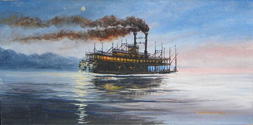


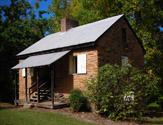









Southern Exposure
A Walk in the Park
Observations and Ramblings from Greenville's Falls Park on the Reedy River
Observations and Ramblings from Greenville's Falls Park on the Reedy River
The photography of Walker Evans, Eudora Welty, Dorothea Lange and Helen Levitt truly impresses me. Their work is always compelling and evocative, seemingly beckoning to tell a story. And quite often it does. The notion of taking photographs of life around you can seem quite elementary, but documentary photography is so much more than randomly snapping pictures. However, every great photograph is not necessarily captured after much examination and deliberation. It goes without saying that intuition, skill and spontaneity all play their parts. Timing, angles, and light/shadow are just a few factors to consider, and one can eventually develop an instinct for recognizing those special moments worth photographing, but I admittedly continue to take some of my best images by accident! A few of those were captured in the summer of 2007 at one of my favorite places: Falls Park on the Reedy River in downtown Greenville, South Carolina. While I dare not compare my photography to that of Evans, Welty, Lange or Levitt, I credit their work as my inspiration and aspire to capture images that, like theirs, will tell a fascinating story.
The handy annual reference, once considered by antebellum farmers to be so reliably true that upon it an oath could be sworn if a Bible were not available, is celebrating 200 years of continuous publication. Named in honor of its founder Robert Grier, an uncle of Confederate States vice president Alexander Hamilton Stephens, the venerable old Southern almanac survived the Civil War and the Great Depression, and is read by over 3 million in thirteen states.
An amateur astronomer, Robert Grier (1780-1848) originally made his astronomical calculations at his family's plantation in Talieferro County, Georgia. With a passion for astronomy, he became a wealthy man from the publication of his Georgia and South-Carolina Almanak. Upon Grier's death, a number of individuals kept the almanac going, eventually changing its name to Grier's Almanac. Today, Grier's is owned and managed by Bryan and Leslie Bachler of Atlanta.
An amateur astronomer, Robert Grier (1780-1848) originally made his astronomical calculations at his family's plantation in Talieferro County, Georgia. With a passion for astronomy, he became a wealthy man from the publication of his Georgia and South-Carolina Almanak. Upon Grier's death, a number of individuals kept the almanac going, eventually changing its name to Grier's Almanac. Today, Grier's is owned and managed by Bryan and Leslie Bachler of Atlanta.
Those Wonderful Ads!
Older issues of Grier's Almanac are desired by collectors because of the advertising. Within the pages of the 1934 issue (pictured below right), one can find ads for Bayer aspirin, Cheney's Expectorant (for coughs) and Feen-a-mint ("The Laxative That's Just Like Chewing Gum"). While these products were quite common and widely used at the time, a few other items were offered by more obscure companies, and following are just a few of the standouts:
Lots of Useful Stuff, Too
Besides a few hilarious ads and plenty of legitimate promotions, Grier's Almanac contains a helpful gardening calendar, zodiac information, a religious section, a chronological listing of memorable events and informing general interest articles.
Older issues of Grier's Almanac are desired by collectors because of the advertising. Within the pages of the 1934 issue (pictured below right), one can find ads for Bayer aspirin, Cheney's Expectorant (for coughs) and Feen-a-mint ("The Laxative That's Just Like Chewing Gum"). While these products were quite common and widely used at the time, a few other items were offered by more obscure companies, and following are just a few of the standouts:
- 6 6 6 a remedy for colds, headache, fever, biliousness, malaria and constipation available in liquid, tablets, nose drops and a salve! (Editor's note: I'd have to be pretty miserable before I would take something called "666.")
- Smith's Worm Oil, a product of the Galenol Company, Inc. of Atlanta. Described as "one of the oldest and most reliable worm medicines sold."
- Lydia E. Pinkham's Vegetable Compound, a "tonic and regulator" for "girls in their teens." The ad states, "Teach her how to guard her health at this critical time . . . When she is a happy, healthy wife and mother she will thank you."
- Securitee, a "renowned prescription in a jellied form" described as the "married woman's sure, safe method." "Are you financially able to take care of babies and give them the proper attention?," the ad asks. "If not it may be best to delay." Haven't times changed? Today, there is considerable debate over whether school kids should learn about contraception and the prevention of sexually transmitted diseases at younger and younger ages. In 1934, amid the Depression, an ad offering some form of pregnancy prevention made no mention of the word sex, of course, but its intent was pretty clear. "Every married couple should have babies, but it is a great injustice to bring the little darlings into the world if all conditions are not just right." Interesting to note, 1934 was probably not one of those years in which conditions were "just right" for raising children for most southern couples.
- Lucky Las Vegas Cologne (Editor's note: If you're willing to throw away your money at the casinos, spending $5.55 on this stuff probably can't hurt!)
- Dragon's Blood Uncrossing Bubble Bath, "used to destroy jinxes" (Editor's note: A normal shower with soap and water suits me just fine. Jinxes don't scare me.)
- "Make Opposing Lawyer Stupid" Oil and Candle (Editor's note: This must have been used by the O. J. Simpson defense team. Oops, I shouldn't have said that!!!)
- "Stop Evil" Spray Cleaner "Chase evil out of home, church, business," says the ad. (Editor's note: Obeying the Bible and saying, "Get thee behind me, Satan," has always worked for me!)
Lots of Useful Stuff, Too
Besides a few hilarious ads and plenty of legitimate promotions, Grier's Almanac contains a helpful gardening calendar, zodiac information, a religious section, a chronological listing of memorable events and informing general interest articles.
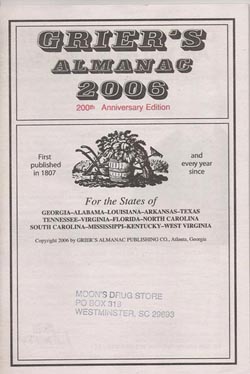
Inevitable Questions
Of course, one can easily straddle all sorts of fine lines, and inevitably ask the myriad questions. At what point does the tried and true pastime of casual people-watching become invasive? Somehow having a camera in one's hand takes the experience to a whole new dimension in the eyes of some, doesn't it? If someone is conspicuous enough -- or, in some cases, inconspicuous enough -- in public to warrant a second glance, does that naturally make the person a fair target for the photographer's lens? These are questions I asked myself as I strolled through Falls Park on several different afternoons in June 2007. Taking photographs and taking note of the activity around me, it proved to be an enlightening experience, to say the least. I probably learned as much about myself as I did the subjects of my photographs.
Of course, one can easily straddle all sorts of fine lines, and inevitably ask the myriad questions. At what point does the tried and true pastime of casual people-watching become invasive? Somehow having a camera in one's hand takes the experience to a whole new dimension in the eyes of some, doesn't it? If someone is conspicuous enough -- or, in some cases, inconspicuous enough -- in public to warrant a second glance, does that naturally make the person a fair target for the photographer's lens? These are questions I asked myself as I strolled through Falls Park on several different afternoons in June 2007. Taking photographs and taking note of the activity around me, it proved to be an enlightening experience, to say the least. I probably learned as much about myself as I did the subjects of my photographs.

Copies of Grier's Almanac are distributed via drug stores, feed & seed dealers and direct mail.
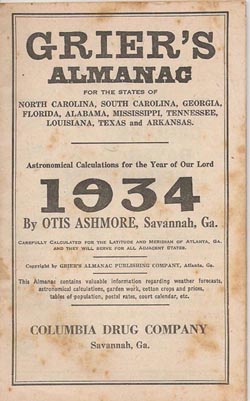

A Picture's Worth a Thousand Words
When I captured the individuals in The Family That Stays Together, I was struck by the closeness of a family strolling side by side, eagerly seeking a better view of the falls. In such a bustling public setting, children are often guarded closely by parents or grandparents, but one seldom encounters such affection and obvious unity like I observed with this family. Oddly enough, it was hours later during my review of the day's photographs that I realized several family members were walking hand in hand. In my mind, at least, this image was transformed from being pleasant and heartwarming to inexplicably beautiful and moving, proving that such tightly woven families are not confined to those portrayed in 1950s television shows.
When I captured the individuals in The Family That Stays Together, I was struck by the closeness of a family strolling side by side, eagerly seeking a better view of the falls. In such a bustling public setting, children are often guarded closely by parents or grandparents, but one seldom encounters such affection and obvious unity like I observed with this family. Oddly enough, it was hours later during my review of the day's photographs that I realized several family members were walking hand in hand. In my mind, at least, this image was transformed from being pleasant and heartwarming to inexplicably beautiful and moving, proving that such tightly woven families are not confined to those portrayed in 1950s television shows.

For nearly half a century, Thomas P. Ashmore made the astronomical calculations for Grier's Almanac. Upon his death in 1882, he was succeeded by his nephew, Otis Ashmore. A Savannah educator and scientist, Otis Ashmore saw the almanac fall on hard times. It was in 1912 that Frank Lamar Fleming of John B. Daniel, Inc., an Atlanta wholesale drug company, acquired the publication at a Savannah bankruptcy auction. In spite of the ownership change, Otis Ashmore remained with Grier's, making astronomical calculations until his death in 1934. Pictured is his last issue.
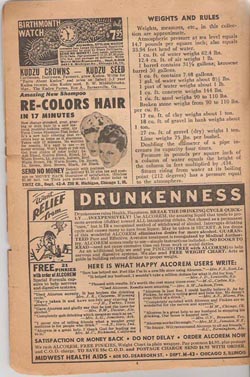
The Family That Stays Together, Digital Photograph, Greg Freeman, June 24, 2007
I first noticed a sunbather as I walked across the Liberty Bridge on June 10, 2007. Pausing to snap some shots of the dramatic waterfalls and downtown skyline, I spotted the nearly nude man lounging on the massive rock around which the river coursed through recesses and naturally carved out trenches. Flamboyantly clad only in a scant leopard print swimsuit, the well-tanned sunbather was juxtaposed where dozens could see him any given hour. As I returned to Falls Park on other occasions throughout the summer of 2007, this scene was repeated time after time. The sunbather could be consistently found on his prominent perch, and an audience -- whether stunned, captivated or amused -- could be seen assembling at any given moment to view a man who was neither inhibited nor insecure.
The Family That Stays Together and Sunbather were taken just steps from the falls' descent. From a similar vantage point, the English-born artist Joshua Shaw (1776-1860) sketched the scene around 1820 in preparation for his oil painting, View of the Reedy River. In its publication, A Paradise of Riches: Joshua Shaw and the Southern Frontier, the Greenville County Museum of Art explains Shaw's intentions (which were not unlike mine): "Shaw made several sketches in the area, focusing special attention on the Reedy River falls. Rather than feature the main waterfall head on, Shaw
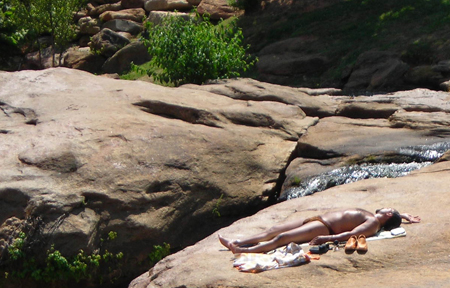
This sampling from the 1953 issue of Grier's Almanac features a half-page ad offering an "amazing liquid that tends to promote aversion (dislike) toward ALL intoxicating drinks." Also, kudzu had apparently not sufficiently invaded the South by 1953. B. W. Middlebrooks of Barnesville, Georgia, was advertising seed and kudzu crowns for sale! Quite a contrast from the previously illustrated 1934 edition, the 1953 issue featured ads from two separate publishers promoting illustrated books on the topic of sex!
Sunbather, Digital Photograph, Greg Freeman, June 10, 2007
chose instead to reverse the viewer's expectations." Employing artistic license, Shaw painted a ridge of mountains along the horizon beyond the valley through which the river flowed. In my photograph of the family strolling toward the falls, it is clear that no such embellishments would be merited today with the dramatic bridge and forest of trees occupying the background.
Lazy Afternoon Nap depicts a young man enjoying a siesta. I first saw him as I entered the park, and couldn't resist taking a photograph. A half hour later when I had returned from my trek downstream, his friends had come out of the water to rejoin him on the riverbank. Needless to say, his reluctance to play in the water was wise. Greenville has since declared the Reedy River polluted, courtesy of leaking sewage lines, and people are now banned from getting into the water for public safety reasons. Every time a boy would bounce off that rock above the pool, it looked painful and dangerous. No doubt, that rock has caused its share of wounded egos and bruised buttocks!
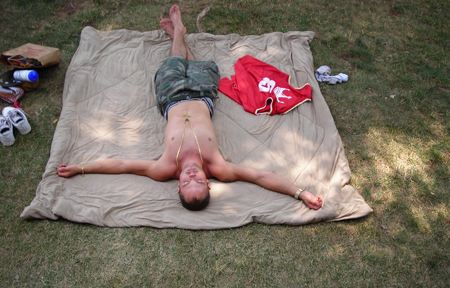
Lazy Afternoon Nap, Digital Photograph, Greg Freeman, June 24, 2007
Another reason for prohibiting activity in the river is evident in Thrill-seeking Boys, the most dramatic of my Falls Park photographs. On numerous occasions, I watched daring teenagers and college-aged kids carefully make their way to just the right spot where they would sit down and, with a good launch, slide down the slippery falls, bouncing off a rock near the bottom into the pool of water below. Sometimes small crowds cheered these spectacles, but I always watched with apprehension.

Thrill-seeking Boys, Digital Photograph, Greg Freeman, June 17, 2007

The last image included here is Couple 'Neath the Weepin' Willow. Taken from beneath the South Main Street Bridge, this photograph features a couple alongside the river. I consider this one of my favorite photographs, but in retrospect I came very close to missing out on the opportunity to capture it. Literally seconds after I took the picture, the couple moved on. Quite honestly, I do not remember their faces. I couldn't tell you if he sported a goatee or she wore sunglasses. I just know that from my vantage point I saw something appealing, a moment worth remembering. I hope they remember it, too.
Couple 'Neath the Weepin' Willow, Digital Photograph, Greg Freeman, June 10, 2007
Any keen observer at Falls Park -- or any other public locale, for that matter -- is sure to receive a refresher course in sociology. In a setting where so many appear to do little more than play, relax or entertain themselves, there is definitely more than meets the eye. The most basic of human behaviors and tendencies are evident, and one is sure to discover that, in spite of our differences, we are all pretty much the same. Perhaps that is why, some years later, I am able to view the subjects of my photographs with intrigue and find endearing beauty in the nature and humanity displayed in each one.
BIBLIOGRAPHY
Liv Osby, "Health risks posed by Reedy concern officials," The Greenville News, March 9, 2008
A Paradise of Riches: Joshua Shaw and the Southern Frontier (Greenville, South Carolina: Greenville County Museum of Art, 2008).
Author: Greg Freeman. Published July 6, 2013.
BIBLIOGRAPHY
Liv Osby, "Health risks posed by Reedy concern officials," The Greenville News, March 9, 2008
A Paradise of Riches: Joshua Shaw and the Southern Frontier (Greenville, South Carolina: Greenville County Museum of Art, 2008).
Author: Greg Freeman. Published July 6, 2013.
Copyright
Southern Edition
All Rights Reserved
Southern Edition
All Rights Reserved
All materials contained on this site, including text and images, are protected by copyright laws and may not be reproduced without prior written permission from the publisher. Where applicable, use of some items contained on this site may require permission from other copyright owners.
Fair Use of text from SouthernEdition.com is permitted to the extent allowed by copyright law. Proper citation is requested. Please use this guide when citing a Southern Edition article.
Contact Greg Freeman or SouthernEdition.comFair Use of text from SouthernEdition.com is permitted to the extent allowed by copyright law. Proper citation is requested. Please use this guide when citing a Southern Edition article.